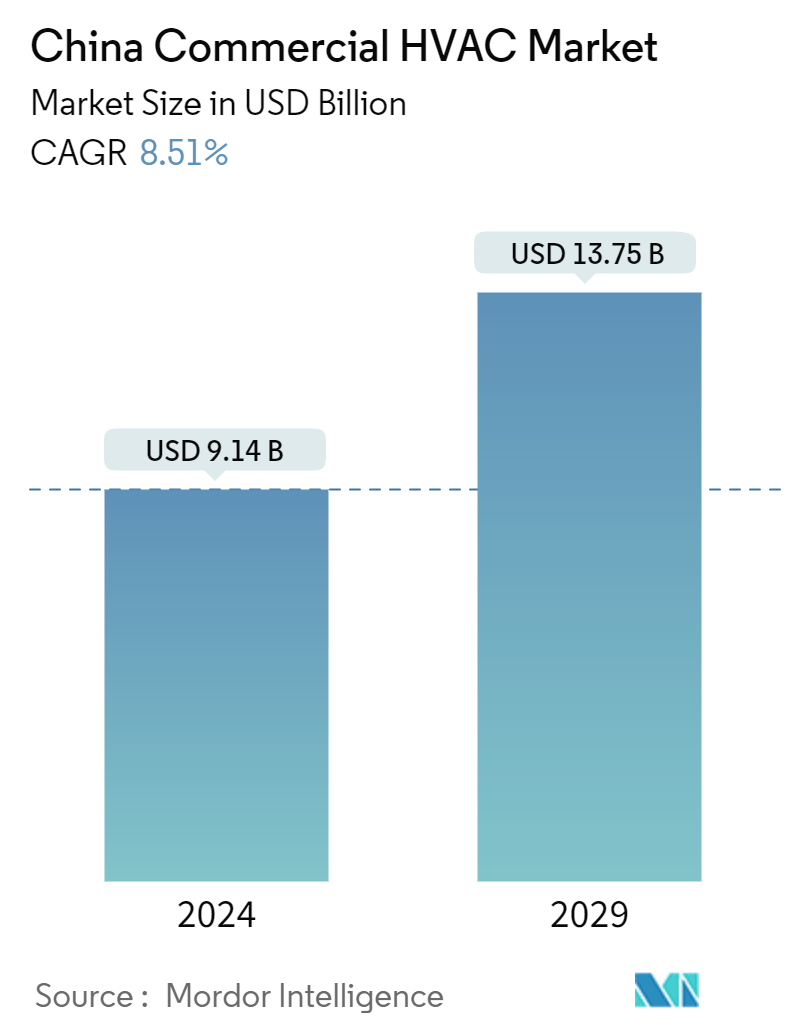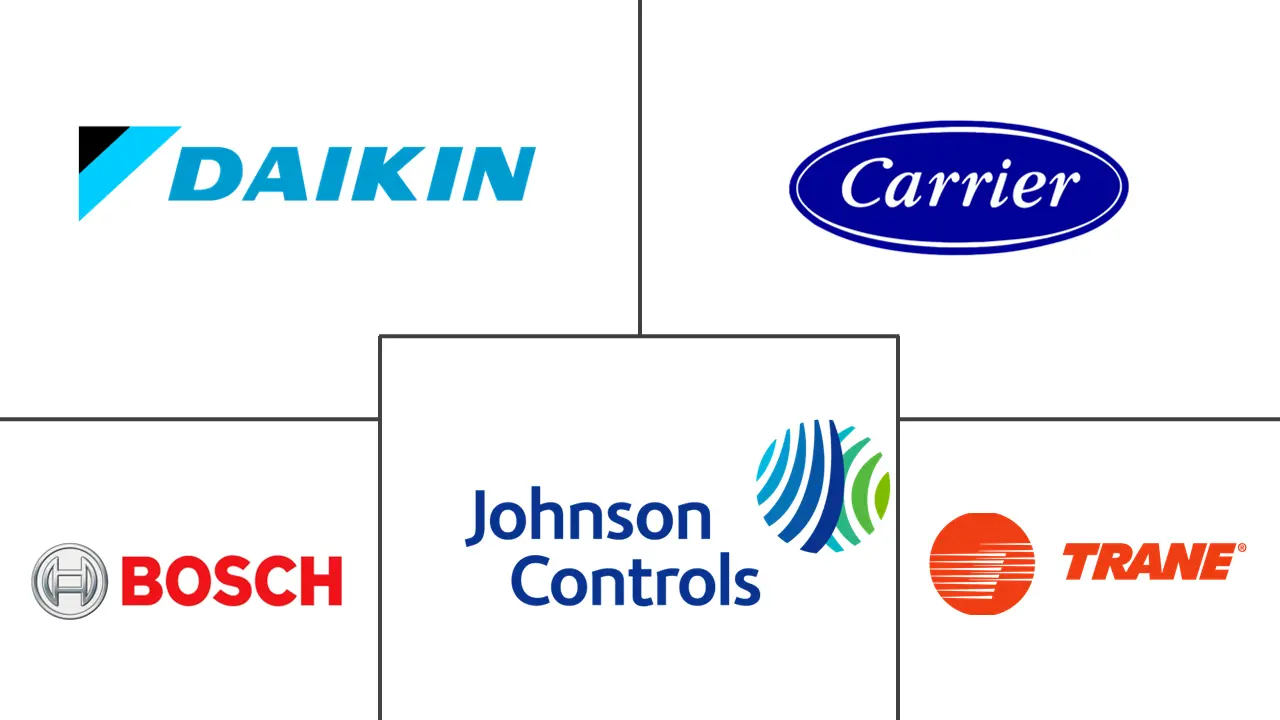Market Size of China Commercial HVAC Industry

| Study Period | 2019 - 2029 |
| Base Year For Estimation | 2023 |
| Market Size (2024) | USD 9.14 Billion |
| Market Size (2029) | USD 13.75 Billion |
| CAGR (2024 - 2029) | 8.51 % |
| Market Concentration | Low |
Major Players
*Disclaimer: Major Players sorted in no particular order |
China Commercial HVAC Market Analysis
The China Commercial HVAC Market size is estimated at USD 9.14 billion in 2024, and is expected to reach USD 13.75 billion by 2029, growing at a CAGR of 8.51% during the forecast period (2024-2029).
- HVAC systems are crucial and essential for any commercial structure to provide occupants with a comfortable atmosphere. For instance, HVAC systems are frequently utilized in many offices to offer suitable temperature and ventilation settings, which helps to improve employee productivity and working conditions and minimize health risks brought on by inadequate humidity levels. This need for HVAC solutions in China is anticipated to increase demand for HVAC equipment such as air handling units.
- China, a key manufacturing hub for HVAC machinery and components, is pivotal in driving market growth. With a robust manufacturing infrastructure, China hosts numerous factories specializing in HVAC equipment. This scale of production ensures economies of scale and translates into competitive pricing. For instance, Heat pumps, a type of HVAC equipment, are poised to be pivotal in China's efforts to peak CO2 emissions by 2030 and attain carbon neutrality by 2060.
- Environmental laws, including the China Green Building Evaluation Label (GBEL), are becoming more prevalent in China. As a result, the country's HVAC industry is turning toward environmentally friendly AHUs with low Global Warming Potential (GWP) and energy-efficient technology.
- In commercial settings, HVAC equipment encompasses an array of components vital for heating and cooling systems. With each additional part in an HVAC unit, the risk of component failure rises, presenting a hurdle to China's HVAC equipment market expansion. Furthermore, when HVAC equipment fails, it raises operating costs for end-users and prompts them to consider alternative products, dampening the demand for HVAC equipment.
- Continuing challenges from macroeconomic factors such as inflation and elevated interest rates persist for the commercial HVAC market in China. Moreover, as equipment and installation costs rise, consumers may opt for repairs over replacements. Furthermore, with China projected to account for 70% of HFC production and consumption by 2035, the HVAC sector faces potential shortages and notable price escalations.
China Commercial HVAC Industry Segmentation
HVAC is a broad array of heating and cooling systems regulating indoor temperature and humidity. Beyond temperature control, these systems enhance indoor air quality through mechanical ventilation and filtration. The HVAC systems include heat pumps, central air conditioners, ductless mini-splits, furnaces, air handling units, and boilers. Additionally, HVAC encompasses the extensive refrigeration systems found in commercial structures.
The study tracks the revenue accrued through the sale of HVAC products in the commercial sector by various players in China. The study also tracks the key market parameters, underlying growth influencers, and major vendors operating in the industry, which supports the market estimations and growth rates over the forecast period. The study further analyses the overall impact of COVID-19 aftereffects and other macroeconomic factors on the market. The report's scope encompasses market sizing and forecasts for the various market segments.
The Chinese commercial HVAC market is segmented by type of component (HVAC equipment [heating equipment, air conditioning /ventilation equipment], and HVAC services) and end-user industry (hospitality, commercial buildings, public buildings, and others). The market sizes and forecasts are provided in value (USD) for all the above segments.
| By Type of Component | ||||
| ||||
| HVAC Services |
| By End-User Industry | |
| Hospitality | |
| Commercial Buildings | |
| Public Buildings | |
| Others |
China Commercial HVAC Market Size Summary
The China commercial HVAC market is poised for significant growth, driven by the increasing demand for efficient heating, ventilation, and air conditioning systems in commercial buildings. As a crucial component for maintaining comfortable and productive environments, HVAC systems are becoming indispensable in offices, schools, hospitals, and other commercial spaces. The market's expansion is further supported by China's robust manufacturing capabilities, which ensure competitive pricing and a steady supply of HVAC equipment. The country's commitment to environmental sustainability, as evidenced by initiatives like the China Green Building Evaluation Label, is steering the industry towards energy-efficient and low Global Warming Potential technologies. This shift is particularly relevant as China aims to peak CO2 emissions by 2030 and achieve carbon neutrality by 2060, with HVAC solutions playing a pivotal role in these efforts.
China's position as a leading manufacturer and exporter of HVAC equipment, including heat pumps, underscores its influence in the global market. The country's commercial HVAC sector is characterized by a fragmented landscape with major players such as Daikin Industries, Carrier Corporation, and Johnson Controls International actively pursuing strategic partnerships, innovations, and acquisitions to enhance their market presence. The growing commercial construction industry and the rise of data centers further drive the demand for advanced HVAC systems, highlighting the sector's potential for substantial growth. Despite challenges like rising equipment costs and macroeconomic factors, the market is expected to thrive, supported by technological advancements and strategic investments in energy-efficient solutions.
China Commercial HVAC Market Size - Table of Contents
-
1. MARKET INSIGHTS
-
1.1 Market Overview
-
1.2 Industry Attractiveness - Porter's Five Forces Analysis
-
1.2.1 Bargaining Power of Suppliers
-
1.2.2 Bargaining Power of Consumers
-
1.2.3 Threat of New Entrants
-
1.2.4 Threat of Substitute Products
-
1.2.5 Intensity of Competitive Rivalry
-
-
1.3 Industry Value Chain Analysis
-
1.4 Impact of COVID-19 Aftereffects and Other Macroeconomic Factors on the Market
-
-
2. MARKET SEGMENTATION
-
2.1 By Type of Component
-
2.1.1 HVAC Equipment
-
2.1.1.1 Heating Equipment
-
2.1.1.2 Air Conditioning /Ventillation Equipment
-
-
2.1.2 HVAC Services
-
-
2.2 By End-User Industry
-
2.2.1 Hospitality
-
2.2.2 Commercial Buildings
-
2.2.3 Public Buildings
-
2.2.4 Others
-
-
China Commercial HVAC Market Size FAQs
How big is the China Commercial HVAC Market?
The China Commercial HVAC Market size is expected to reach USD 9.14 billion in 2024 and grow at a CAGR of 8.51% to reach USD 13.75 billion by 2029.
What is the current China Commercial HVAC Market size?
In 2024, the China Commercial HVAC Market size is expected to reach USD 9.14 billion.

